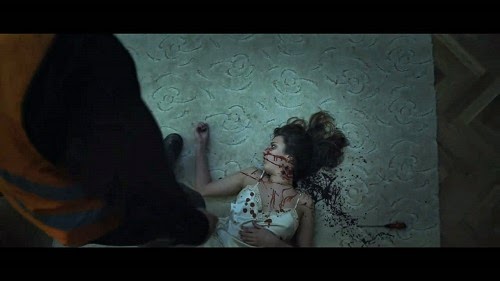
Sooner or later I was going to encounter a film at the Fantasia Film festival that would make me rethink waiting in line for four hours for tickets for it. Well, Helfi C.H. Kardit's
Guardian is that film! Hey, but since it's my fifteenth film out of twenty-five, I'm not that upset. Also, I sat next to one of my favorite online critics, Andrew Mack from Twitch, who was very sweet, and also put up with these two people literally devouring each other/rabidly making out right in front of us. Throughout the ENTIRE film. Behind us sat another couple who had personally found the loudest chip bags on the planet, which they crumpled and crinkled repeatedly throughout the screening. To top it all, there was a speaker issue with the dialogue track during the first ten minutes of the film, which tended to highlight the acute shaky camerawork and goofy choreography--before they fixed things and we started the film all over again. So call me distracted. Despite everything, Andrew wrote a really
generous and upbeat review over at Twitch, which makes me feel a little guilty that I fully plan to trash the damn thing. Oh well.
First off, I have no patience for bratty, whiny teenagers. None. In horror films, I'm usually completely okay with them dying, often the sooner the better. I'm from the generation where you would leave the house in the morning, and your parents would expect you home for dinner, and who cares whatever the hell you did, as long as you didn't get pregnant, get arrested or do hard drugs. Benign neglect. No "helicopter parenting." In
Guardian, the teenage Marsya (Belinda Camesi) is constantly in a snit because her Mom, Sarah (Dominique Diyose) insists that her daughter learn martial arts and be able to protect herself. Marsya would far prefer to hang out with her friend Thalia and whine about her mean Mom. Well, it turns out that Sarah's on the right track, when a tough blonde criminal named Paquita (Sarah Carter) escapes from custody and seems hell-bent on getting a hold of her daughter.
 |
| Paquita is a lot more bad ass then you might think |
Paquita is not the only person who seems to be after the whiny teenager and her protective Mom. Some goons literally shred the family's house in deluge of bullets, and if that isn't enough, out comes the rocket launcher to finish the job. The two somehow escape unscathed into their hidden muscle car straight out of Point Blank or Bullitt, and no matter how many car chases and bang ups that thing is in, it still manages to come out unharmed (hello continuity)! Let me tell you, there are so many car chases and gun fights, and almost no one seems to ever run out of ammunition. The end result of all this firepower is that the scenes lose all their sense of suspense, and actually just become tedious. When, oh when, will someone get killed? Someone who matters? That's part of the film's problem: you don't really care about these people. Is the cop, Roy (Nino Fernandez), going to allow the goon businessman-turned-politician Oscar (Tio Pakusodeo), to continue this unrestrained mayhem? Do we care? What type of poetry will Oscar sport next in his utterly loony turn as villain? That question is more interesting.
 |
| Another interchangeable AKB (ass-kicking babe) |
Guardian is proof that throwing a bunch of "strong women" into a film, and then having them "Kick Ass" is just not enough to hold a film together (even if it
was enough to make me interested in seeing it). Sure, the violence and bullet fetish are both gratuitous, but it doesn't notably change the film by having all these weapons carried by babes. At times, I thought I was watching an
Andy Sidaris film, especially when the knife wielding babe who kills Sarah's husband in the opening 10 minutes, comes back to handle Sarah personally. She does not reappear for the
entire film until that moment, and then she just seems to keep pulling more knives out of thin air. Oh, and she doesn't have a name. Meanwhile, plenty of women seem to work with/for Paquita (who named this blonde?), but the only thing they seem to share is unmotivated loyalty toward her and a certain level of
hotness. They do not possess names either. Thankfully, most of these women characters are dressed practically instead of wearing bikinis or stilettos, but that caveat doesn't make the film any more progressive.
 |
| Nameless female assassin from 10 years ago hasn't aged a day and shows up at end with the same knives |
Fortunately,
Guardian's narrative centers around women. Unfortunately,
Guardian relies on some very one-dimensional female stereotypes--cold, nonsupporting Mom, uber-sacrificial Mom, whiny teenager, ass kicking babe. That's it. Now I can understand that bullet-riddled spectacle might take precedence, but the extremely shaky camerawork, rigid choreography, and histrionic musical cues serve to undermine the visceral adrenaline rush of that spectacle. I
love handheld camerawork, but this camera movement had no motivation other than "ACTION!!!" Combine those almost tedious, overlong action sequences with character about which we barely care and you have a rather big disappointment. I didn't even stick around for the director Q & A because I couldn't fake enthusiasm for this film. I wanted out of there. Bummer.



























